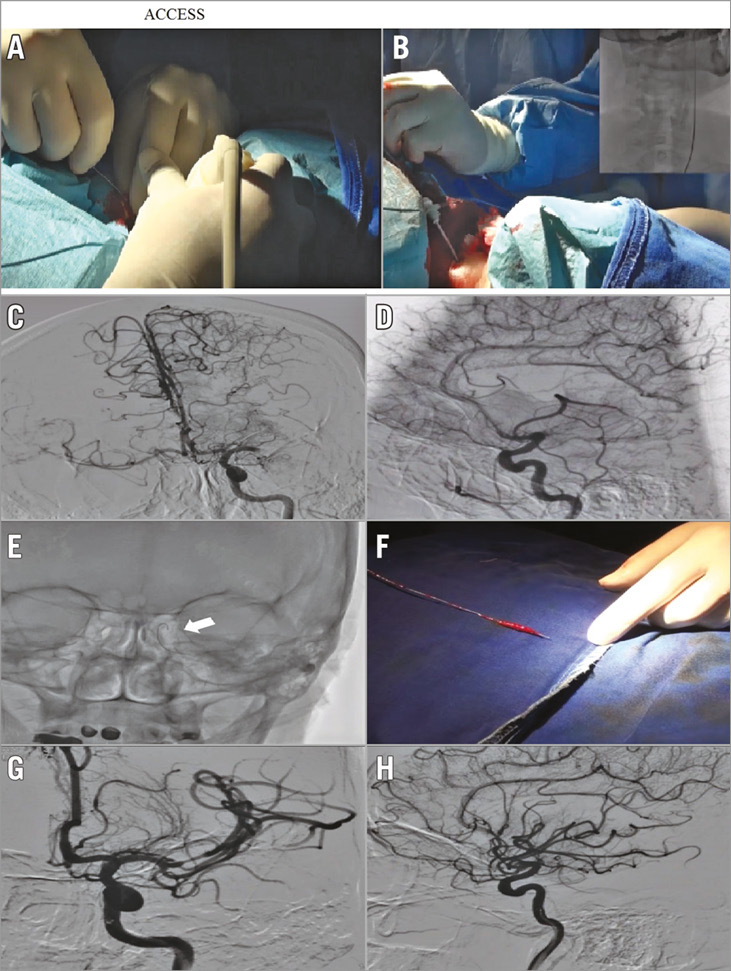

In view of recent randomised trials, endovascular therapy (ET) has become a class I indication for the treatment of acute ischaemic stroke due to anterior circulatory occlusion in selected patients1,2. Although the traditional vascular access approach for such procedures is the common femoral artery, difficult aortic arch anatomy can cause significant time delays with detrimental consequences for optimal functional recovery3,4. In such circumstances, direct carotid access may offer several advantages.
A 36-year-old woman with a known history of dilated cardiomyopathy presented with sudden onset right-sided weakness. Neurological examination revealed right-sided hemiparesis (upper limb 2/5 and lower limb 3/5), right-sided hemianopia and slight motor aphasia. The calculated National Institutes of Health Stroke Scale (NIHSS) score was 18. Diffusion magnetic resonance (MR) imaging showed early ischaemic changes on the left lenticulustriate area, while a left middle cerebral artery occlusion was evident on MR angiography. The patient was immediately transferred to the catheterisation laboratory.
We accessed the left common carotid artery under ultrasound guidance using a 5 Fr micropuncture kit (Panel A, Panel B). A 3 cc contrast hand injection was performed to confirm optimal vessel entry. Baseline cerebral angiography was performed by hand injection of contrast and site of the middle cerebral artery (MCA1) occlusion was identified (Panel C, Panel D). A 5 Fr Revive™ IC intermediate catheter (Codman Neuro, Raynham, MA, USA) was custom modified in order to facilitate the procedure (Moving image 1). The distal end was shortened by 40 cm and the proximal part by 3 cm from the hub. They were then connected to each other via a 4 Fr introducer sheath after its ends had been dilated by a 5 Fr sheath dilator. The occlusion at the middle cerebral artery was crossed with a WHISPER® hydrophilic guidewire (Abbott Vascular, Santa Clara, CA, USA) and the modified aspiration catheter was connected to a 5 Fr Aspire manual aspiration device (Control Medical Technology, Park City, UT, USA), which was advanced into the site of the total occlusion (Panel E), resulting in TICI 2 flow in the MCA. Using a stent retriever, thrombus was retracted (Panel F) resulting in normal perfusion (TICI 3) in the MCA with minimal residual stenosis at the occlusion site (Panel G, Panel H). The carotid access site was closed using a 5 Fr Boomerang® nitinol self-expanding closure device (Cardiva Medical, Inc., Santa Clara, CA, USA) with good haemostasis (Supplementary Figure 1). During the procedure only 2,000 units of intravenous heparin were administered as the patient was already on oral anticoagulation. The patient was discharged two days later without significant neurological sequelae.
Direct carotid access for endovascular stroke therapy may be a suitable option for timely access in selected cases of difficult aortic arch anatomy. Larger studies are needed to evaluate the safety and efficacy of this approach.
Conflict of interest statement
The authors have no conflicts of interest to declare.
Supplementary data
Supplementary Figure 1. Successful closure of access site (A) with excellent haemostasis (B).
Moving image 1. Custom modification of delivery system. Aspiration catheter custom modified with the distal end shortened by 40 cm and the proximal part by 3 cm from the hub. They were then connected to each other via a 4 Fr introducer sheath after its ends had been dilated by a 5 Fr sheath dilator.
Supplementary data
To read the full content of this article, please download the PDF.
Custom modification of delivery system.Aspiration catheter custom modified with the distal end shortenedby 40 cm and the proximal part by 3 cm from the hub. They werethen connected to each other via a 4 Fr introducer sheath after itsends had been dilated by a 5 Fr sheath dilator.

